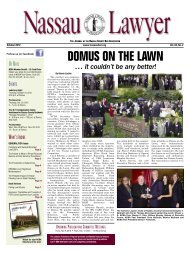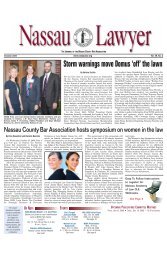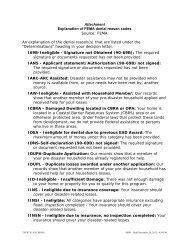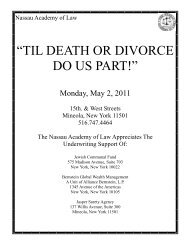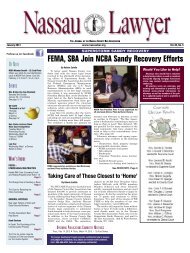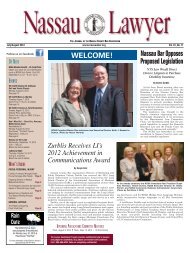443 F.3d 180 Page 9443 F.3d 180(Cite as: 443 F.3d 180)defeating act if movants (having been kept out <strong>of</strong>litigation) had injected themselves in the case in orderto attack a judgment that did not then affect them.A Rule 60(b)(4) motion must be made "within a reasonabletime" after entry <strong>of</strong> the judgment.Fed.R.Civ.P. 60(b). "Courts have been exceedinglylenient in defining the term 'reasonable time,' withregard to voidness challenges. In fact, it has been <strong>of</strong>tstatedthat, for all intents and purposes, a motion tovacate a default judgment as void 'may be made atany time.' " State St. Bank, 374 F.3d at 179 (quotingBeller & Keller v. Tyler, 120 F.3d 21, 24 (2dCir.1997)). In our decision in Central Vermont PublicService Corp., the Rule 60(b) motion was not untimelyalthough the movant had waited more thanfour years to bring its motion, and did so when"prompted by a suit ...." 341 F.3d at 188, 189. Weheld in State Street Bank, "where a party has previouslyfiled a motion to vacate a default judgment thatfailed to raise a voidness argument and subsequentlyadvances such an argument in a Rule 60(b)(4) motionmore than a year after the entry <strong>of</strong> the default judgment,the Rule 60(b)(4) motion should be denied asuntimely." 374 F.3d at 179. [FN8]FN8. Rule 60(b)(6) does not have a one yearlimit, but instead requires that the motionmust be made within a "reasonable time."Fed.R.Civ.P. 60(b)(6). To determine thetimeliness <strong>of</strong> a motion brought pursuant toRule 60(b)(6), we look at the particular circumstance<strong>of</strong> each case and "balance the interestin finality with the reasons for delay."Kotlicky v. United States Fidelity & Guar.Co., 817 F.2d 6, 9 (2d Cir.1987). Notably, aRule 60(b)(6) motion requires "extraordinarycircumstances," which "typically do notexist where the applicant fails to move forrelief promptly." 12 MOORE'S FEDERALPRACTICE § 60.48[3][c]; Transaero, Inc.v. La Fuerza Area Boliviana, 24 F.3d 457,462 (2d Cir.1994). Moore's Federal Practicedoes not define "promptly," instead it citesTransaero, which holds, "[n]or, in the circumstances<strong>of</strong> this case, does the fact thatBAF did not learn <strong>of</strong> the entry <strong>of</strong> the defaultjudgment for several years constitute 'extraordinarycircumstances' justifying Rule60(b)(6) relief." Id. at 462. Because we laterdecline to rule on the district court's granting<strong>of</strong> the Rule 60(b)(6) motion, we do not decidewhether the Rule 60(b)(6) motion wastimely.*191 Judge Trager distinguished the movants herefrom those in Beller & Keller, as the movants herehad not filed any previous appeal or motion to vacate.He reasoned:Regardless <strong>of</strong> whether or not they theoretically hadthe option <strong>of</strong> doing so, they have provided a simpleexplanation for their actions: they waited untilplaintiffs had actually sued them under DCL §273-a. Taking into account this lenient standard,the motion was filed within a reasonable time,namely, shortly after the commencement <strong>of</strong> [the2004 actions for fraudulent conveyances].Grace XI, at 10. Judge Trager's observation was especiallyappropriate considering that the allegedlyfraudulent transactions occurred nearly fifteen yearsearlier.In a typical case, five years from the judgment to aRule 60(b) motion would be considered too long bymany courts. This case, however, is anything buttypical. Plaintiffs created significant delay by bringinga fraudulent conveyance claim more than fifteenyears after the conveyances were alleged to havebeen made, and five years after the judgment thatthey could not satisfy. Plaintiffs' argument thatmovants have waited too long, when movantsbrought this motion only weeks after plaintiffs filedthis lawsuit, is unpersuasive. In this case, we are interestedless in the number <strong>of</strong> years from the time <strong>of</strong>judgment, than we are in what has happened in between.It was well within Judge Trager's discretion todetermine that the Rule 60(b) motion was timely,because being directly sued provides "good cause."V. The Judgment is void under Rule 60(b)(4)[6] Movants contend that the judgment here is voidfor several reasons: (a) the default judgment was enteredwithout any evidentiary hearings, detailed affidavits,or documentary evidence having been presentedto the district court; (b) a corporation cannotappear pro se in federal court; (c) there were materialconflicts <strong>of</strong> interest between the corporate <strong>of</strong>ficersnegotiating the settlement agreement and the corporationitself; and (d) the judgment was in violation <strong>of</strong>Rule 54(c) <strong>of</strong> the Federal Rules <strong>of</strong> Civil Procedurebecause plaintiffs obtained relief in excess and differentin kind from that sought in their complaint.© 2009 Thomson Reuters. No Claim to Orig. US Gov. Works.
443 F.3d 180 Page 10443 F.3d 180(Cite as: 443 F.3d 180)Plaintiffs cite Cablevision Systems New York CityCorp. v. Lokshin, 980 F.Supp. 107, 112(E.D.N.Y.1997), for the proposition that a districtcourt has the discretion to determine the amount <strong>of</strong>damages to be included in a default judgment by anevidentiary hearing, detailed affidavits, or documentaryevidence. This is true, yet here, there were none<strong>of</strong> the above: no evidentiary hearings, no detailedaffidavits, and no documentary evidence. This wasbecause the parties settled. Plaintiffs enumerate manyitems that would have been included in these hearingshad they taken place. In fact, plaintiffs assert thatthe reason that Rosenstock settled on behalf <strong>of</strong> Briggswas because plaintiffs previewed for Rosenstock theoverwhelming evidence that would be used in theinquest. However, the record indicates that JudgeWolle never held an evidentiary hearing, receiveddetailed affidavits, or considered documentary evidence.Judge Wolle held a status conference on July28, *192 1997, in which plaintiffs' counsel appearedin person and Rosenstock appeared by telephonefrom Florida. On July 31, 1997, an order from JudgeWolle urged the parties to continue settlement negotiationsand imposed a deadline <strong>of</strong> August 4, 1997.Plaintiffs and Rosenstock then signed the stipulation<strong>of</strong> settlement, with Rosenstock acting on behalf <strong>of</strong>Briggs and himself.Judge Trager wrote that it is "well-settled" that a "'corporation may appear in the federal courts onlythrough licensed counsel.' " Grace XI, at 12 (quotingRowland v. California Men's Colony, 506 U.S. 194,201-02, 113 S.Ct. 716, 121 L.Ed.2d 656 (1993)).Judge Trager, citing Mullin-Johnson Co. v. Penn MutualLife Insurance Co., 9 F.Supp. 175(N.D.Cal.1934), explained that this rule "has beenapplied to dismiss any action or motion filed by acorporation purporting to act pro se." Grace XI, at 12.He also found that "[a] corporation cannot execute astipulation <strong>of</strong> settlement while appearing pro se in afederal court." Id. at 13.[7] Judge Trager is correct. This Court held in SECv. Research Automation Corp., 521 F.2d 585 (2dCir.1975), that "[i]t is settled law that a corporationmay not appear in a lawsuit against it except throughan attorney, and that, where a corporation repeatedlyfails to appear by counsel, a default judgment may beentered against it pursuant to Rule 55, F[ed]. R. Civ.P." Id. at 589 (internal citation omitted); accordJacobs v. Patent Enforcement Fund, Inc., 230 F.3d565, 568 (2d Cir.2000). Further, this Court held inEagle Associates v. Bank <strong>of</strong> Montreal, 926 F.2d 1305(2d Cir.1991), that "we long have required corporationsto appear through a special agent, the licensedattorney." Id. at 1308.Plaintiffs attempt to invoke Schifrin v. ChenilleManufacturing Co., 117 F.2d 92 (2d Cir.1941), arguingthat even if Briggs retained an attorney, this attorneywould have "merely carried out an agreement"made by defendant Rosenstock. In distinguishing thiscase, Judge Trager explained one <strong>of</strong> the justificationsfor requiring that corporations be represented bycounsel: "the 'lay litigant' lacks many <strong>of</strong> the attorney'sethical responsibilities." Grace XI, at 13 (quotingJones v. Niagara Frontier Transp. Auth., 722 F.2d20, 22 (2d Cir.1983)). Attorneys do not exist merelyto act as information conduits or to communicatewith opposing counsel. Rather, they inform, advise,counsel, explain matters <strong>of</strong> law, and do much more. Itis impossible to know what role an attorney forBriggs would have played, but it is likely that shewould have played some role in the negotiation beyondsimply passing along information to plaintiffs,especially considering that Rosenstock and Briggshad conflicting interests. Plaintiffs argue that it is"fundamentally unfair" to leave them without a remedy,but plaintiffs brought this situation upon themselvesby negotiating an extraordinarily high settlementby telephone with a bankrupt pro se defendantwho spoke for a bankrupt corporate shell that lackedlegal counsel. Even the sole shareholder <strong>of</strong> a corporationis differently situated legally from the corporation,whose interests " 'frequently overlap but are notidentical in all respects.' " Grace XI, at 13 (quotingBatac Dev. Corp. v. B & R Consultants, Inc., 2000WL 307400, at *2 (S.D.N.Y. March 23, 2000)).Plaintiffs do not cite any case law supporting theproposition that corporations may negotiate settlementspro se. They merely revert to their previousargument that Judge Trager had discretion under Rule55(b)(2) to approve the settlement. However, theplain language <strong>of</strong> Rule 55(b)(2) does not support thiscontention. See Fed.R.Civ.P. 55(b)(2). The propercourse <strong>of</strong> action for plaintiffs was to ask *193 thecourt to "conduct such hearings or order such referencesas it deem[ed] necessary and proper," as Rule55(b)(2) provides.© 2009 Thomson Reuters. No Claim to Orig. US Gov. Works.
- Page 1 and 2:
Nassau Academy of LawCLE Live Class
- Page 3 and 4:
McKinney's Debtor and Creditor Law
- Page 5 and 6:
McKinney's Debtor and Creditor Law
- Page 7 and 8:
McKinney's Debtor and Creditor Law
- Page 9 and 10:
McKinney's Debtor and Creditor Law
- Page 11 and 12:
McKinney's Debtor and Creditor Law
- Page 13 and 14:
McKinney's Debtor and Creditor Law
- Page 15 and 16:
McKinney's Debtor and Creditor Law
- Page 17 and 18:
McKinney's Debtor and Creditor Law
- Page 19 and 20:
BAKER & HOSTETLER LLP45 Rockefeller
- Page 21 and 22:
usiness of defendant Bernard L. Mad
- Page 23 and 24:
BACKGROUND, THE TRUSTEE, AND STANDI
- Page 25 and 26:
Madoff who received fraudulent tran
- Page 27 and 28:
ased on fictitious profits and for
- Page 29 and 30:
28. BLMIS funds were also used to p
- Page 31 and 32:
Madoff, and her niece, Shana Madoff
- Page 33 and 34:
42. Ruth Madoff was never an employ
- Page 35 and 36:
FIRST CAUSE OF ACTIONTURNOVER AND A
- Page 37 and 38:
66. At the time of each of the Two-
- Page 39 and 40:
Transfers; (b) directing that the S
- Page 41 and 42:
EIGHTH CAUSE OF ACTIONUNDISCOVERED
- Page 43 and 44:
TENTH CAUSE OF ACTIONDISALLOWANCE O
- Page 45 and 46:
111. Mrs. Madoff benefited from the
- Page 47 and 48:
WHEREFORE, the Trustee respectfully
- Page 49 and 50:
2(c)(3): (a) preserving the Subsequ
- Page 51 and 52:
302 B.R. 760 Page 1302 B.R. 760(Cit
- Page 53 and 54:
302 B.R. 760 Page 3302 B.R. 760(Cit
- Page 55 and 56:
302 B.R. 760 Page 5302 B.R. 760(Cit
- Page 57 and 58:
302 B.R. 760 Page 7302 B.R. 760(Cit
- Page 59 and 60:
302 B.R. 760 Page 9302 B.R. 760(Cit
- Page 61 and 62:
302 B.R. 760 Page 11302 B.R. 760(Ci
- Page 63 and 64: 302 B.R. 760 Page 13302 B.R. 760(Ci
- Page 65 and 66: 302 B.R. 760 Page 15302 B.R. 760(Ci
- Page 67 and 68: 302 B.R. 760 Page 17302 B.R. 760(Ci
- Page 69 and 70: 302 B.R. 760 Page 19302 B.R. 760(Ci
- Page 71 and 72: 394 B.R. 721 Page 1394 B.R. 721, 50
- Page 73 and 74: 394 B.R. 721 Page 3394 B.R. 721, 50
- Page 75 and 76: 394 B.R. 721 Page 5394 B.R. 721, 50
- Page 77 and 78: 394 B.R. 721 Page 7394 B.R. 721, 50
- Page 79 and 80: 394 B.R. 721 Page 9394 B.R. 721, 50
- Page 81 and 82: 394 B.R. 721 Page 11394 B.R. 721, 5
- Page 83 and 84: 394 B.R. 721 Page 13394 B.R. 721, 5
- Page 85 and 86: 394 B.R. 721 Page 15394 B.R. 721, 5
- Page 87 and 88: 394 B.R. 721 Page 17394 B.R. 721, 5
- Page 89 and 90: 394 B.R. 721 Page 19394 B.R. 721, 5
- Page 91 and 92: 394 B.R. 721 Page 21394 B.R. 721, 5
- Page 93 and 94: 397 B.R. 642 Page 2397 B.R. 642(Cit
- Page 95 and 96: 397 B.R. 642 Page 4397 B.R. 642(Cit
- Page 97 and 98: 397 B.R. 642 Page 6397 B.R. 642(Cit
- Page 99 and 100: 397 B.R. 642 Page 8397 B.R. 642(Cit
- Page 101 and 102: 397 B.R. 642 Page 10397 B.R. 642(Ci
- Page 103 and 104: 397 B.R. 642 Page 12397 B.R. 642(Ci
- Page 105 and 106: 397 B.R. 642 Page 14397 B.R. 642(Ci
- Page 107 and 108: 443 F.3d 180 Page 2443 F.3d 180(Cit
- Page 109 and 110: 443 F.3d 180 Page 4443 F.3d 180(Cit
- Page 111 and 112: 443 F.3d 180 Page 6443 F.3d 180(Cit
- Page 113: 443 F.3d 180 Page 8443 F.3d 180(Cit
- Page 117 and 118: 443 F.3d 180 Page 12443 F.3d 180(Ci
- Page 119 and 120: Page 2257 A.D.2d 526, 684 N.Y.S.2d
- Page 121 and 122: Page 4257 A.D.2d 526, 684 N.Y.S.2d
- Page 123 and 124: Page 6257 A.D.2d 526, 684 N.Y.S.2d
- Page 125 and 126: 770 N.Y.S.2d 421 Page 22 A.D.3d 780
- Page 127 and 128: Page 14 A.D.3d 495, 773 N.Y.S.2d 71
- Page 129: Page 34 A.D.3d 495, 773 N.Y.S.2d 71
- Page 132 and 133: 780 N.Y.S.2d 409 Page 29 A.D.3d 553
- Page 134 and 135: Page 134 A.D.3d 231, 824 N.Y.S.2d 3
- Page 136 and 137: Page 334 A.D.3d 231, 824 N.Y.S.2d 3
- Page 138 and 139: Page 2991 F.2d 31(Cite as: 991 F.2d
- Page 140 and 141: Page 4991 F.2d 31(Cite as: 991 F.2d
- Page 142 and 143: Page 6991 F.2d 31(Cite as: 991 F.2d
- Page 144 and 145: FRAUDULENT TRANFERENCESRonald M. Te
- Page 146 and 147: Nursing home case_ Transfer of pers
- Page 148 and 149: Sections 548 and 544 work in concer
- Page 150 and 151: U.S. Supreme CourtBFP v. Resolution
- Page 152 and 153: example, from net 15 to COD; or cha
- Page 154 and 155: Bankruptcy Code Section§ 548. Frau
- Page 156: Ron Terenzi is a founding partner a



